 W
WThe culture of Bengal defines the cultural heritage of the Bengali people native to eastern regions of the Indian subcontinent, mainly what is today Bangladesh and the Indian states of West Bengal, Tripura and Assam's Barak Valley, where the Bengali language is the official and primary language. Bengal has a recorded history of 1,400 years. The Bengali people are its dominant ethnolinguistic group. The region has been a historical melting point, blending indigenous traditions with cosmopolitan influences from pan-Indian subcontinental empires. Bengal was considered to be the richest part of Islamic medieval India and during the era of the Bengal Sultanate it was described to be a major trading nation in the world, while during Mughal times, having triggered the proto-industrialization, its economy was worth 12% of global GDP. However, significant socio-economic inequalities existed during this period. As a part of the Bengal Presidency, it also hosted the region's most advanced political and cultural centers during British rule. Historically Feudalism has been widespread in the entire eastern Indian region. The feudal system flourished to a large extent under the British administration, which served as a means to exploit the Indian peasants by the British colonizers. This created a class of rich landlords in Bengal and a large population of poor peasants. It is noteworthy that a major portion of the Bengali intellectual community during the British era emerged from this wealthy class of landlords, as primarily they belonged to well educated families and got the economic opportunities to receive English education, often from abroad. The lower social classes remained in abject poverty and illiteracy. Thus, although the contribution of the Bengali intellectual community has been immense towards literature, science, politics and the Indian freedom movement, but still as it flourished under an exploitative imperial government, it mostly constituted of individuals belonging to the wealthy landlord families.
 W
WThe culture of West Bengal is an Indian culture which has its roots in the Bengali literature, music, fine arts, drama and cinema. Different geographic regions of West Bengal have subtle as well as more pronounced variations between each other, with Darjeeling Himalayan hill region and Duars showing particularly different socio-cultural aspects.
 W
WAlkap is a Bengali folk dance popular in the districts of Murshidabad, Malda and Birbhum in West Bengal and Chapai Nawabganj, Randajshahi in Bangladesh. It has also spread to the adjoining areas of Jharkhand and Bihar such as Dumka and Purnia.
 W
WAlpana or alpona refers to colourful motifs, sacred art or painting done with hands and paint which is mainly a paste of rice and flour on auspicious occasions in Bengal. The word Alpana is derived from the Sanskrit alimpana, which means 'to plaster' or 'to coat with'. Traditionally, it was drawn by the women of the house before sunset. It is also a folk art in Bengal.
 W
WThe architecture of Bengal, which comprises the modern country of Bangladesh and the Indian states of West Bengal, Tripura and Assam's Barak Valley, has a long and rich history, blending indigenous elements from the Indian subcontinent, with influences from different parts of the world. Bengali architecture includes ancient urban architecture, religious architecture, rural vernacular architecture, colonial townhouses and country houses and modern urban styles. The bungalow style is a notable architectural export of Bengal. The corner towers of Bengali religious buildings were replicated in medieval Southeast Asia. Bengali curved roofs, suitable for the very heavy rains, were adopted into a distinct local style of Indo-Islamic architecture, and used decoratively elsewhere in north India in Mughal architecture.
 W
WThe Indian state, West Bengal has a rich cultural heritage. Due to the reign of many different rulers in the past, arts and crafts in West Bengal underwent many changes giving an artistic diversity today in the forms of traditional handicrafts, terracotta, painting and carving, dance, music except of natural beauty and glorious past the state has the strong hold of art and architecture which made the state so unique.
Asian Paints Sharad Shamman is an excellence award given to the best decorated Durga Puja Pandal in Kolkata during the festival in October. Since its inception in 1985, Asian Paints Sharad Shamman has been heralded as the true achievement for excellence in decorating the abodes for Goddess Durga. As time has progressed there have been numerous awards being given by many other companies for creative excellence, but still Asian Paints Sharad Shamman is considered the most important award and the rightful judgement for excellence. It is a trendsetter for all the later awards.
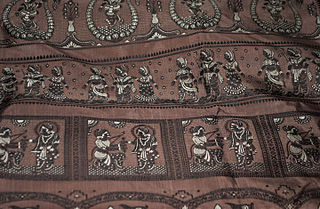 W
WBaluchari Sari is a type of sari, a garment worn by women in Bangladesh and Indian States of West Bengal. This particular type of sari originated in West Bengal and is known for depictions of mythological scenes on the pallu of the sari. It used to be produced in Murshidabad but presently Bishnupur and its surrounding areas of West Bengal are the only place where authentic Baluchari saris are produced. It takes approximately one week to produce one such sari. In 2011, the Baluchari Sari was granted the status of Geographical Indication for West Bengal in India.
 W
WBankura horse is the terracotta horse, produced in Panchmura village in Bankura district in the Indian state of West Bengal. It has been praised for “its elegant stance and unique abstraction of basic values.” Originally used for village rituals, it now adorns drawing rooms across the world as symbols of Indian folk-art. It is the logo of All India Handicrafts.
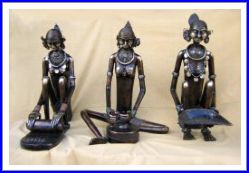 W
WBastar Wooden Crafts are traditional Indian wooden crafts that are manufactured in the Bastar district of Chhattisgarh state, India. The wood-crafting work has been protected under the Geographical indication (GI) of the Agreement on Trade-Related Aspects of Intellectual Property Rights (TRIPS) agreement. It is listed at item 84 as "Bastar Wooden Craft" of the GI Act 1999 of the Government of India with registration confirmed by the Controller General of Patents Designs and Trademarks.
 W
WThe Bengal School of Art commonly referred as Bengal School, was an art movement and a style of Indian painting that originated in Bengal, primarily Kolkata and Shantiniketan, and flourished throughout the Indian subcontinent, during the British Raj in the early 20th century. Also known as 'Indian style of painting' in its early days, it was associated with Indian nationalism (swadeshi) and led by Abanindranath Tagore (1871-1951), but was also being promoted and supported by British arts administrators like E. B. Havell, the principal of the Government College of Art and Craft, Kolkata from 1896; eventually it led to the development of the modern Indian painting.
 W
WBengal temple architecture is about temple styles developed and used in Bengal, particularly the chala, ratna and dalan temples.
 W
WThe Bengal Renaissance, also known as the Bengali Renaissance, was a cultural, social, intellectual, and artistic movement that took place in the Bengal region of the British Raj, from the late 18th century to the early 20th century. Historians have traced the beginnings of the movement to the victory of the British East India Company at the 1757 Battle of Plassey, as well as the works of reformer Raja Rammohan Roy, considered the "Father of the Bengal Renaissance," born in 1772. Nitish Sengupta stated that the movement "can be said to have … ended with Rabindranath Tagore," Asia's first Nobel laureate.
 W
WBengali theatre primarily refers to theatre performed in the Bengali language. Bengali theatre is produced mainly in West Bengal, and in Bangladesh. The term may also refer to some Hindi theatres which are accepted by the Bengali people.
 W
WBipattarini (Bipottarini), also termed as Bipodtarini or Bipadtarini is a Hindu goddess (Devi), worshipped in Bangladesh, West Bengal, Orissa Assam and surrounding areas. Closely associated with goddess Sankattarani and considered as one of the 108 Avatars of the goddess Durga, Bidaptarini is prayed to for help in overcoming troubles. Her legends are recounted during the annual festival associated with her, the Bipadtarini Vrata, observed by women, on the Between Dwitiya to Dashami {(Ulta Ratha Yatra ) or } or Between 2nd day to 10th Day of the Shukla paksha Tuesday or Saturday in month of Ashada according to the Hindu Calendar. Her legends established her name, Bipada – Tarini, which literally means deliverer from troubles.
 W
WThe Bishnupur gharana is a form of singing that follows the dhrupad tradition of Hindustani music, one of the two forms of Indian classical music.
 W
WBanbibi, the lady of the forest, also Bandevi, Bandurga and Byaghradevi is a guardian spirit of the forests venerated by both the Hindu and the Muslim residents of the Sundarbans. She is called upon mostly by the honey-collectors and the woodcutters before entering the forest for protection against the attacks from the tigers. It is believed that the demon king, Dakkhin Rai, an arch-enemy of Banbibi actually appears in the disguise of a tiger and attacks human beings.
 W
WBowbazar is a neighbourhood of Central Kolkata, in Kolkata district in the Indian state of West Bengal.
 W
WChalchitra is a part of Bengal Patachitra. It referred to the Debi Chal or Durga chala, the background of the Durga Pratima or idol. Originally, these were used to give a proper proportion to the structure. This tradition is very ancient and is still maintained.
 W
WChhau dance also spelled as Chau or Chhaau, is a semi classical Indian dance with martial and folk traditions, with origins in the Kalinga(Odisha) region from Mayurbhanj, and panned out to its variants in the states of West Bengal and Jharkhand. It is found in three styles named after the location where they are performed, i.e. the Purulia Chau of West Bengal, the Seraikella Chau of Jharkhand and the Mayurbhanj Chau of Odisha.
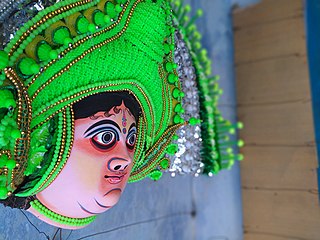 W
WThe Chhau mask is a traditional cultural heritage of Purulia in the Indian state of West Bengal. The main difference between the Purulia Chhau dance and the Odisha Chhau dance is in the use of the mask. Purulia Chhau uses the mask in dance, but Odisha does not, thereby combining facial expression with body movement and gesture. The Chhau mask of Purulia is registered on the List of Geographical Indications. As the basic difference of Purulia Chhau the mask is unique and traditional.
 W
WThe Chukri system is a debt bondage or forced labour system found in Kidderpore and other parts of West Bengal. Under this system a female can be coerced into prostitution in order to pay off debts. She generally works without pay for one year or longer in order to repay a supposed debt to the brothel owner for food, clothes, make-up, and living expenses.
 W
WThe Cinema of West Bengal, also known as Toollywood, refers to the Indian Bengali language film industry based in the Tollygunge region of Kolkata, West Bengal, India. The origins of the nickname Toollywood, a portmanteau of the words Tollygunge and Hollywood, dates back to 1932. It was a historically important film industry, at one time the centre of Indian film production. The Bengali film industry is known for producing many of Indian cinema's most critically acclaimed global Parallel Cinema and art films, with several of its filmmakers gaining prominence at the Indian National Film Awards as well as international acclaim.
 W
WThe culture of Darjeeling, India, is quite diverse and unique. The two predominant religions are Hinduism and Vajrayana Buddhism. Dashain, Tihar, Buddha Jayanti, Christmas, Holi, Ram Navami, etc. are the main festivals. Besides, the diverse ethnic populace of the town also celebrates several local festivals. Buddhist ethnic groups such as the Lepchas, Bhutias, Sherpas, Yolmos, Gurungs, and Tamangs celebrate new year called Losar in January/February, Maghe Sankranti, Chotrul Duchen, and Tendong Lho Rumfaat. The Kiranti Rai people (Khambus) celebrate their annual Sakela festivals of Ubhauli and Udhauli. Deusi and Bhaileni are songs performed by men and women, respectively, during the festival of Tihar. All these provide a "regional distinctness" of Darjeeling's local culture from the rest of India.
 W
WDakshin Ray is a revered deity in the Sundarbans in India and Bangladesh who rules over beasts and demons. He is regarded as the overall ruler of the Sundarbans. The God is worshipped by all those who enter the Sundarban forests of West Bengal, for subsistence, irrespective of their caste, creed or religion.
 W
WDarjeeling Carnival is a ten-day carnival arranged in the town of Darjeeling, West Bengal, India.
 W
WThe dhak is a huge membranophone instrument from India. The shapes differ from the almost cylindrical to the barrel. The manner of stretching the hide over the mouths and lacing also varies. It suspended from the neck, tied to the waist and kept on the lap or the ground, and usually played with wooden sticks. The left side is coated to give it a heavier sound.
 W
WDhakis are traditional drummers who play the dhak (drum) during Hindu festivals, primarily in Bengal. Drum beats are an integral part of the five-day-long annual festivities associated with Durga Puja but dhakis are losing out to pre-recorded CDs and cassettes.
 W
WDharmaraj is a Hindu deity of justice worshipped by villagers in the traditional Rarh region in the present day Indian state of West Bengal as one of their special village gods. He is considered as the spiritual father of Yudhisthira, the elder brother of the Pandavas and an epic character of Mahabharata. Dharmaraj is represented by a shapeless stone daubed with vermillion and is normally placed under a tree or placed in the open, but sometimes enshrined in a temple. The worship takes place in the months of Baisakh [Buddha Purnima], Jaistha and Asarh on the day of full moon and sometimes on the last day of Bhadro. Dharmaraj is worshipped by all castes.
 W
WDhokra is non–ferrous metal casting using the lost-wax casting technique. This sort of metal casting has been used in India for over 4,000 years and is still used. One of the earliest known lost wax artefacts is the dancing girl of Mohenjo-daro. The product of dhokra artisans are in great demand in domestic and foreign markets because of primitive simplicity, enchanting folk motifs and forceful form. Dhokra horses, elephants, peacocks, owls, religious images, measuring bowls, and lamp caskets etc., are highly appreciated. The lost wax technique for casting of copper based alloys has also been found in China, Egypt, Malaysia, Nigeria, Central America, and other places.
 W
WGohona Bori is a dried dal dumpling. It is popular in Bengali cuisine. It is a well known food item in Purba Medinipur. It is also known as Naksha Bori. It is made with black lentil, Poppy seed and various spices. The woman of the house made the dish. In 2016, IIT Kharagpur applied to get the geographical Indication for Gohona Bori.
 W
WThe Guptipara Rathayatra is being celebrated in Guptipara in Hooghly District of West Bengal since the 1730s. The chariot is a nabaratna-style wooden temple, where the presiding deity in the chariot is that of Radharaman Jiu. The Guptipara Rathayatra is second only to the Puri Rathayatra in terms of the distance covered. One of the unique events of Guptipara Rathayatra is the bhandara loot, which is held a day before the purnayatra or the ulto rath. A month long fair is held in Guptipara on the occasion of the festival. Every year thousands of devotees take part in the festival.
 W
WKavigan, Kobi Gaan, Kobi Lorai or Kabigan is a form of Bengali folk performance wherein folk poets sing and perform. A verbal duel among the poets, this mystic minstrels art was popular with rural folk form in nineteenth century in Bengal region, which includes the Indian state of West Bengal and Bangladesh.. The mythological themes from both Hindu and Muslims religious texts were commonly used for Kobi Gaan.
 W
WKhoai Mela or Shonibarer haat is a weekly Saturday afternoon bazaar set up by local artisans in Santiniketan, Birbhum district, West Bengal. The Khoai Mela has now become a part of the culture of the Bengali people and has been taking place for over 20 years. It takes place every Saturday on the bank of the Khoai or Kopai River. The Mela is named after this Khoai region and River. This Mela is also called Shanibarer haat due to its opening day.
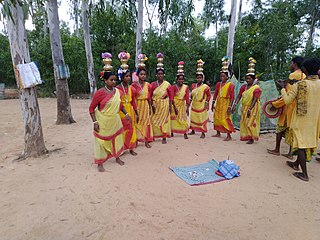 W
WThe Lungi Panchi Dance is a traditional dancing style of the Santal people of West Bengal. This dance is performed by both men and women and is accompanied by traditional music.
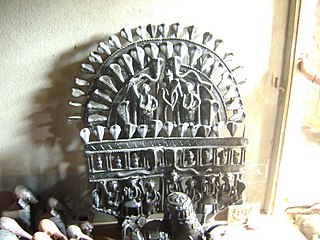 W
WManasa chali, or Manasa bari, is a type of idol of Debi Manasa made of Terracota in Panchmura, West Bengal, India. It typically features a small figure or a group of three figures in the middle with rows of snake hoods fanning out in a half moon shape. Chali or bari is Bengali for 'the shade of something'. Chali is referred to here as 'the shade of idol' or 'the besh of idol', like Chalchitra. These idols have two basic colors, reddish-yellow and black.
 W
WMask or Mukhosh of West Bengal, as it is known for has a mysterious history. Mostly it uses for the Mask Dance, the folk dance of West Bengal. The wearing of these masks is connected with early types of folklore and religion. There are various type of masks made up of clay, wood, sponge wood or shola, pith, paper, metal etc. Generally, half of these masks are made up of clay, pith and paper and wooden masks are very rare. Some of these masks come from the Tribal of West Bengal. Geographically, West Bengal comes well within this mask using culture zone. Masks in West Bengal is mostly used in folk dance. UNESCO selected The Rural Craft Hub of Bengal to showcase their artwork in Paris in 2015.
 W
WBengali music comprises a long tradition of religious and secular song-writing over a period of almost a millennium. Composed with lyrics in the Bengali language, Bengali music spans a wide variety of styles.
 W
WThe music of West Bengal includes multiple indigenous musical genres such as Baul, Ramprasadi, Bishnupuri Classical, Kirtan, Shyama Sangeet, Rabindra Sangeet, Nazrul Geeti, Dwijendrageeti, Prabhat Samgiita, Agamani-Vijaya, Patua Sangeet, Gambhira, Bhatiali, Bhawaiya, Bengali Rock.
 W
WNabadwip-er lal doi, also known as Kheer doi or Chakku doi, is one of the most famous types of confectionery in the Bengal region of the Indian subcontinent, originating in present-day West Bengal, India. Though curd is usually white, red curd is a distinct type of confectionery. Red curd of the Nadia's Nabadwip type is very popular. Kali Ghosh or Kalipad Modak of Nabadwip was the inventor of the confectionery in 1930. One of the most famous red curd shop is "Laxmi Narayan Confectionery Store", that is 150-years old curd shop. After preparing the curd, it can be stored up to ten days.
 W
WNakshi kantha, a type of embroidered quilt, is a centuries-old Bengali art tradition of the Bengal region, notable in Bangladesh and Indian states of West Bengal, Tripura and part of Assam. The basic material used is thread and old cloth. Nakshi kanthas are made throughout Bangladesh, but the greater Mymensingh, Jamalpur, Bogra, Rajshahi, Faridpur and Jessore areas are most famous for this craft.
 W
WPahela Baishakh is the first day of the Bengali calendar which is also the official calendar of Bangladesh. This festival is celebrated on 14 April in Bangladesh and 15 April in the Indian states of West Bengal, Tripura, and Assam by Bengalis regardless of religious faith.
 W
WPatachitra or Pattachitra is a general term for traditional, cloth-based scroll painting, based in the eastern Indian states of Odisha and West Bengal. Patachitra artform is known for its intricate details as well as mythological narratives and folktales inscribed in it. Pattachitra is one of the ancient artworks of Odisha, originally created for ritual use and as souvenirs for pilgrims to Puri, as well as other temples in Odisha. Patachitras are a component of an ancient Bengali narrative art, originally serving as a visual device during the performance of a song.
 W
WPatua Sangeet or Poter Gan is a cultural tradition of Bengal Patachitra. It is performed by a Patua. It is famous in the village part of West Bengal like Birbhum, Jhargram, Bardhaman and Murshidabad as a folk song of West Bengal.
 W
WRabindra Sangeet, also known as Tagore Songs, are songs from the Bengal region written and composed by the Bengali Polymath Rabindranath Tagore, winner of the 1913 Nobel Prize in Literature, the first Indian and also the first non-European to receive such recognition. Tagore was a prolific composer with approximately 2,232 songs to his credit. The songs have distinctive characteristics in the music of Bengal, popular in India and Bangladesh.
 W
WThe Raashchakra or The holy wheel is a structure built during the Raashmela that is held in honour of Lord Krishna or Madanmohan in Cooch Behar, India. From the time of the Maharajas, the Raash Chakra in Cooch Behar is made by a Muslim family of ghughumari area every year. This year, 2019, the CHAKRA has been built b=y Altab Mian. The fair is held just 100m from the Madanmohan Temple.
 W
WThe Rathayatra of Mahesh is the second oldest chariot festival or Rath Yatra in India and oldest in Bengal, having been celebrated since 1396. It is held in Mahesh, a historical locality within Serampore in the Indian state of West Bengal. It is a week-long festival and a grand fair is held at that time. People throng to have a share in pulling the long ropes (Rosshi) attached to the chariots of Lord Jagannath, Balarama and Subhadra on the journey from the temple to Mahesh Gundicha Bari and back within 8th day.
 W
WSantiniketan Leather Goods are leather products made in Santiniketan and surrounding villages near Kolkata, West Bengal, India. The material used is vegetable tanned leather with art work done by touch dyeing. Its artistic leather bags are popular in foreign markets and are exported to many countries including Japan and the U.S. They are generally made of E. I. Leather from sheepskin and goatskin.
 W
WShakta Rash or Shakta Rasa or Shakta Ras is the most celebrated festivals of Nabadwip, West Bengal, India. This festival is celebrated thirty-five days after the autumnal Durgapuja celebration or fifteen days after Kali puja in Kartik Purnima. To the people of Nabadwip Rash Festival is everything. The entire commonwealth eagerly wait for this festival all year round.
 W
WSindur Khela, literally meaning 'vermillion game', is a Bengali Hindu tradition where women smear each other with sindur on Vijayadashami, the last day of the Durga Puja. On the day of the Vijayadashami after the conclusion of the ritual worship, married Bengali Hindu women apply sindur on the forehead and feet of the goddess and offer sweets to her. Then they put sindur on each other's faces and offer sweets to each other.
 W
WTant sari is a traditional Bengali sari, originating from the Bengal region in the eastern part of the Indian subcontinent, and usually used by Bengali women. It is traditionally made by the weavers from almost all over Bangladesh and the Indian states of West Bengal, Tripura, and Assam's Barak Valley, but typically few places like Dhaka, Tangail, Narayanganj of Bangladesh and Murshidabad, Nadia, Hooghly of West Bengal are famous for tant sari weaving. Tant sari are woven from cotton threads and distinguished by its lightness and transparency. It is considered to be the most comfortable sari for the hot and humid climate in the Indian subcontinent.
 W
WTusu Festival is a folk festival held on the last day of the Bengali month of Poush, i.e., Makar Sankranti, so also known as Makar Parav in local languages. It is a unifying form of local common faith and the joy of the harvest. associated with harvesting. At the end of the festivities, the immersion of the image of Tusu is done vividly and with songs which have a melancholic ring. Rural fairs are also organised during the festival is held. Tusu puja is practiced in the rural areas of Bankura, Purulia, Bardhaman and Hooghly districts of West Bengal. Tusu festival is also celebrated by the Tea-tribes in Assam and Jharkhand.